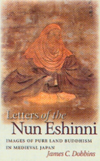Letters of the Nun Eshinni: Images of Pure Land Buddhism in Medieval Japan
James C. Dobbins
Honolulu: University of Hawaii Press, 2004
259 pp.; $25.00 (paper)
With Letters of the Nun Eshinni, James Dobbins has provided a precious gift to those interested in women’s experiences of Buddhism in times past. He has translated into English the preserved letters of Eshinni, the wife of Shinran, founder of the Jodo Shinshu school of Pure Land Buddhism. The letters, addressed to their youngest daughter and never previously translated in full, are a rare window into the life of a medieval Japanese woman. Even had Eshinni not been connected to one of the most important men in Japanese Buddhist history, this collection of letters, with its displays of affection, concern, pragmatism, and religious insight, would merit close attention.
The translations themselves actually take up the shortest chapter of the book, as there are only ten letters known to modern scholars. Still, they are a valuable resource for women’s religious and mundane concerns during an important period in Japanese history. Eshinni was both a typical and a unique woman of her time. Her letters are useful in a general sense because they are some of the few writings by women, especially those outside the highly cultivated circles of urban royalty, available today. We see her struggles with famine, disease, age, and other problems of the age. We also hear the strains of deep love for her family and servants, and piety toward Amida Buddha, the devotional heart of Pure Land Buddhism. Dobbins is adept at teasing out the hints contained in Eshinni’s letters and using them to weave broader discussions of life in medieval Japan. He is also attentive to alternate sources of information overlooked in many earlier discussions of medieval Japanese history, such as material objects, to give a fuller account of the way people actually lived their Buddhism. As such, his book is useful to anyone with a desire to learn more about the era that gave birth to Japanese Pure Land, Zen, and Nichirenism.
The letters are also useful, of course, for learning about Eshinni herself as well as her historically important kin. Eshinni represented a new turning of the dharma wheel in Japan, as the Jodo Shinshu school broke from reliance on strenuous practices unsuited to the laity and boldly authorized marriage among its clergy. Eshinni and Shinran as a couple were the first role models for this new Buddhist paradigm, a living assertion that authentic Buddhist spiritual practice could take place within the context of the home. Dobbins is sensitive to the understanding they had of the sacredness of their bond: “What seems most profound about their relationship is their mutual recognition of a sanctity in one another. Their physical embrace represented for them the conjoining of the most powerful spiritual dimensions of each other.” Sexuality and women’s place within medieval Japanese religion, and culture more broadly, are the primary areas of Dobbins’ investigation. Of particular note is his discussion of the way in which women such as Eshinni seem to have disregarded orthodox Buddhist pronouncements about their alleged spiritual inferiority, forging instead a parallel women’s Buddhism that was more affirmative toward their gender.
For those familiar with modern, nonmythological understandings of Pure Land Buddhism, Dobbins provides a helpful discussion of the contrast between medieval and modernist approaches to religion. Much of his work is an attempt to demonstrate how medieval Buddhists understood their religion, eschewing the many anachronistic contemporary depictions that subtly distort their subject. In particular, he uses insights gleaned from Eshinni’s letters to complicate the purely humanistic portrait of Shinran popular in Pure Land circles today, restoring him to the context of his own time.
If this book has a flaw, it’s that it is sometimes repetitious. And while the letters and the discussion centered on them specifically are new and important, some of the other sections of the book are less groundbreaking, representing more of a skillful synthesis of available scholarship on medieval Japanese Buddhism by Dobbins and others. However, for readers unfamiliar with newer understandings of Buddhism in Kamakura-era Japan, this book would serve as an excellent introduction. Letters of the Nun Eshinni will be a resource referred to many times in coming years by those who seek to better comprehend the history of women’s Buddhism.
Thank you for subscribing to Tricycle! As a nonprofit, we depend on readers like you to keep Buddhist teachings and practices widely available.